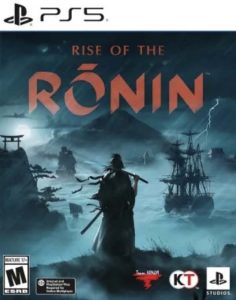Rise Of The Ronin
(available on PlayStation 5 only)
Feudal Japan has always been a pretty popular setting, not just for video games, but for media as a whole. And it’s understandable why, they were times of great turmoil for the citizens of Japan and the samurai and ronin are often depicted as strong honour bound warriors, the storytelling potential is near limitless. That being said though, a lot of them only really seem to focus on a couple of select time periods, most commonly in the 1600’s during the Edo period – the only real exception I can think of is Ghost of Tsushima which takes place in 1274 (during the Kamakura period). To make up for that we now have Rise of the Ronin, taking place in the mid-1800’s, during the Bakumatsu, hailed as one of the darkest periods in Japanese history. Rise of the Ronin was developed by Team Ninja and was released on 22nd March 2024 as a PlayStation 5 exclusive.
Story
You play as a member of the Veiled Edge, a resistance group whose warriors fight in pairs, being referred to as Twin Blades. You and your partner go on a mission to kill American naval officer, Mathew C. Perry, and steal a message sent to him. During the duo’s confrontation with Perry, they are intercepted by a warrior called the Blue Demon who clearly outmatches them in skill. The showdown ends with one of the Twin Blades escaping with the letter and the other getting left behind. Time passes and you wake up to your village being attacked by the Shogunate, during said attack you learn that your Twin Blade is still alive, prompting you to leave the Veiled Edge, forcing you to fight your master to the death to do so. Now with your goal in mind, you venture to Yokohama, where you will become intertwined in a strife between Japan’s Shogun and an Anti-Shogunate faction and meet new faces, including those famous from the time period, all in the hopes of finding your lost partner.
The story is ok, you do get attached to the protagonists’ main motivation, as well as the ongoing war, however it doesn’t really leave much of an impression. A big part of this is the characters, there are so many of them and aside from Ryoma Sakamoto and a few of the Anti-Shogunate members, they’re all pretty bland and forgettable. In my opinion, it goes on for a bit too long, reminding me a lot of Final Fantasy XVI strangely enough, where I thought there were plenty of points where the game could have ended but didn’t.
I’m also not really a big fan of how the game follows the Pro-Shogunate and the Anti-Shogunate storylines. I thought it would be treated as some kind of morality system, where you can choose who you side with in multiple missions to decide the course of the story and the world as a whole, this wasn’t really the case. You only really pick a side on a couple of missions and dialogue options, and the story will have you swapping sides constantly against your will. It’s like the game was trying to have it both ways (have a linear narrative and one where your choices dictate the outcome), and as a result kind of fails at both.
Presentation
If you’re going into the game expecting it to be graphically on par with other modern releases, you’re going to be disappointed. Rise of the Ronin looks like it was made for both previous and modern consoles despite being a PlayStation 5 exclusive, with character models and environments being fairly undetailed, though still fairly colourful. Don’t get me wrong, the game doesn’t look bad, at the very least it’s serviceable, though I would be lying if I said it wasn’t a little underwhelming.
While in performance mode, the game runs excellently. Throughout my playthrough, I didn’t notice any frame rate drops and or the slightest bit of lag. Or at least I didn’t in gameplay, in cutscenes however I’m pretty sure the frame rate was cut in half as I found it to be a bit choppier and not nearly as smooth. I suspect that this is because the cutscenes were shown in presentation mode. Obviously, if you want your game running smoothly it’s going to be during gameplay moments, though that doesn’t stop the FPS drop in cutscenes from being any less jarring.
The voice acting for this game is honestly a little underwhelming. While not entirely emotionless, the line deliveries are still kind of bland with not a lot of emotion being conveyed, aside from a couple of lines. I played this game in English dub, and I will admit the voices at times were a bit distracting. The actors for the Japanese characters attempted to pull off thick Japanese accents to fairly mixed results. I understand why they did this, as the game also involves American and British characters, which have the appropriate accents, and you do get used to it after a while, but it is a little distracting at first.
I will acknowledge, I have been a bit mixed on most of the presentation, so I will at the very least complement the soundtrack. As expected from games based within this setting, the game utilises a lot of traditional Japanese string and woodwind instruments and it sounds great. The music elevates the tension and intensity of combat and even has different songs depending on the kinds of battle, making the fights feel more impactful and just being more epic as a whole. Then there are the songs you hear when wandering the streets of Yokohama or Edo, which sound peaceful and tranquil, while the streets are far from safe, they give the aura that the place is harmless.
World Design & Exploration
As you play through Rise of the Ronin, you’ll arrive at three different locations, Yokohama, Edo and Kyoto. Each of these areas will consist of a small map split up into different sections containing a series of side quests and collectables for you to collect and complete. While two of these maps contain wide open fields and forests for you to ride through, the main attraction is with the city in the centre, which will contain a majority of facilities, such as Apothecaries and Blacksmiths, though you can also find Black Marketeers and Peddlers randomly while exploring. You can travel to and from each of these locations by accessing the Testament of the Soul, doing so will also take you to a different point in the story as well, so if you’re worried about missing any side quests or collectables, you can always come back to previous locations.
The fastest way for you to get from place to place is by finding Veiled Edge Banners. These essentially act a lot like the bonfires or other checkpoints in your average Soulslike, not only being a warp point that you can fast travel to or a place you will respawn after dying, but you can also rest here to replenish your supplies, if you have any in storage that is.
When you can’t fast travel, however, don’t fear as you have plenty of tools to aid you in traversal. No doubt the main one you’ll be using is your trusty steed, which can be called from and ridden almost anywhere. On top of that, you can use a grappling hook, which is essential for climbing cliffs and reaching rooftops and can be really fun to use; it can even be used underwater for improved swiftness. Finally, you have a glider for if you want to jump off tall buildings and mountains and fly for a brief time, this last one I’m a bit mixed on. I like gliders in pretty much every game they’re introduced, same with this one, but not as much as usual, mostly due to how quickly it drains stamina and how quickly it descends with very few ways of lifting yourself back into the air.
Combat
Rise of the Ronin is an action game with RPG and Soulslike mechanics. You have access to a large number of weapon types that were common during the time period, both melee and ranged, and each have very different move sets and advantages depending on the playing style you wish to go with. Even the ranged weapons work differently, with rifles and bows for example, they’re designed to be used on enemies at a further range, thus require you to stop and aim at them, shurikens and revolvers on the other hand, are used in close range battles and can be used to whittle down an opponent’s stamina and can even halt the enemy’s attack if done at the right time.
Yes, stamina, or more accurately Ki, is very much a thing in this game. This is where I heavily compare this game to Sekiro: Shadows Die Twice, as a lot of this games’ combat is less about erasing your opponent’s health, and more about diminishing their Ki and performing a Critical Hit when their stance is broken. Of course there are multiple ways of doing this, just attacking an opponent can be enough to completely decimate their Ki, but the most effective way is by using your Counter spark move just as an enemy is about to hit you to deflect the attack, not only knocking a chunk out of their Ki but even replenishing some of yours. Of course, this requires a lot of practice as well as some trial and error but believe me there is nothing more satisfying than being able to deflect an entire string of attacks. Of course you have Ki as well, that can be whittled down as well, either from attacking, dodging and blocking. If you’re hit and your Ki is reduced completely, your stance will break, and you won’t be able to move for a few seconds so don’t get careless.
On top of your normal combos, you have abilities called Martial Skills. These are attacks that use a lot of Ki to unleash a powerful attack on one or sometimes multiple enemies. Each of these attacks can be changed to become more powerful by holding down or repeatedly pressing the button depending on the attack. Enemies also have Martial Skills, which are indicated by a blood like aura surrounding them, that cannot be blocked, the only way to avoid them is by dodging, then deflecting it with a Counter spark. Once again it takes some time to get the timing right, but it’s incredibly satisfying when you’re able to pull it off.
One of the best ways to get the advantage against opponents is by swapping between Combat Styles. Each weapon has multiple different combat styles that you can unlock as you proceed throughout the game, by completing story and side missions, each of which having very different move sets and Martial Skills. These come in three different types: Ten, Chi and Jin, and each type will give you an advantage and disadvantage against enemies carrying certain weapons in a rock paper scissors like format, mostly it’ll affect the effectiveness of your counter spark ability. This is a mechanic that I really like, first of all I like that it can really change up your move set, not only making using one weapon less boring but also giving you more options if you don’t like one particular style for whatever reason. I also like that it doesn’t force you to swap between weapon types to get the better advantage, I found myself very attached to the Paired Swords and did not want to swap them for a different weapon, so not having to really improved my time with the game. It’s also not too punishing if you don’t have the right Combat Style, there definitely is a difference when using an incompatible style, but it’s not glaringly obvious, so you’re not going to be severely punished for not finding the right one.
Some missions will involve you working with other allies, oftentimes infiltrating an enemy stronghold, or going into a great battle. During these missions, you’ll be able to swap control to one of your compatriots and gain the advantage by doing so, such as by attacking your opponent while they’re distracted by the character you were previously controlling. If you or an ally fall in battle they’re not gone for good, you’ll be able to move over to them and revive them at half health, though it doesn’t require one of your medicines to do so, so it can only be done a finite amount. These missions will always end with a boss, and these are extremely fun, they’ll have an entirely different and more complex move set that you’ll have to learn and they’re very challenging in the best of ways.
Side Quests and Collectables
I mentioned Side Quests previously, and there is a surprising amount of them, if you’re anything like me, you’ll likely find yourself spending most of your playtime on these.
For starters, characters you’ve come into contact with throughout the story will ask you for your aid with a particular task of theirs. These can include, gathering items for them, escorting them somewhere, simply defending them from enemies, amongst other tasks.
What I like about these is that a lot of these quests tie into one another and very few of them feel alike. Some of these can majorly affect the bonds with some characters and can even lead to the deaths of some of them. Completing these will increase your bond with those you’ve helped and can even help forge new ones.
One of the best ones in my opinion is the Public Orders. These are indicated by a large red circle on your map. A bunch of ruffians have occupied a small section of the area and you’re tasked with entering that area and slaying them. Some of these will only include a small handful of enemies while some will involve way too many for you to take on at once, requiring some more stealthy tactics. Completing these will guarantee you a Veiled Blade Banner as well as a small cache of materials and items. Why do I really like these missions? It’s just fun to take out a group of enemies, and I enjoyed finding different ways of doing so. To go along with Public Orders, you’ll also find fugitives, either within the Public Orders or just on their own in the world, that you’ll have to kill. These fugitives are basically just more powerful regular enemies that require a bit more work to kill, but they’re still fun to fight.
I know you cat lovers are going to love this one… you can collect cats in the game, no really! Someone instructs you to find all of her missing cats fairly early on and you can find them all across the map. Some of these will be fairly difficult to find, requiring some of the most complex platforming you can do in this game. There are also some sleepy kitties that you’ll have to sneak up on in order to collect, otherwise they’ll run away, and you’ll have to leave for a short while before you can try again. It’s weirdly fun and satisfying to find and gather up all these cats, not to mention strangely peaceful. My one complaint is how quickly the cats want to run away from me (get back here and let me pet you dammit).
Like most modern games, this game has a photo mode, and there’s even a series of collectables based around it. You’re tasked with taking pictures of historical landmarks and very pretty landscapes, needing to get the angle just right in order to get the perfect photo. This is a really peaceful one, and like the cats, it’s strangely satisfying. Even though it wasn’t required I found myself spending a good while trying to get the best picture I could, it’s simple but a lot of fun.
Finally, are the Shrines, and these are pretty simple. You just find them in the world and pray to them, doing so nets you a Skill Point that can be used to improve your character and unlock new skills.
Flaws
One thing that I really didn’t like about this game was the frequency that I was getting weapons. I found myself getting weapons very often, it’s almost impossible for you to leave a battle without getting at least one new one. Each of these weapons have different effects outside of just attack power as well as different rarities. Yep, it’s the ol’ looter-shooter logic that’s been plaguing games as of late. My biggest problem with it is that this kind of looter-shooter style of weapon collecting doesn’t really work with this kind of game. As I said, I was very attached to the Paired Swords from the very beginning, and I found that, at the start at least, I wasn’t getting that many of that weapon type, at the very least I wasn’t getting any of the good ones, meaning that I had to use a different weapon for a good portion of the game, forcing me to completely change how my stats worked, all because the game wasn’t giving me the weapon type I wanted. Yes, I did eventually start getting Paired Swords dropped more frequently, but it never felt rewarding, and it just got a bit tiresome after a while.
The second problem that I have is how the game allocates the stats. You have four different stats in this game: Strength, Dexterity, Charm and Intellect, each of which work differently and scale better with different weapons. This game also has skill trees, where you can allocate points to unlock and upgrade different abilities. The problem? The skill trees and stats are linked, meaning that in order to upgrade your stats, you must unlock something on the related skill tree. The problem with this is that there are multiple abilities on each of these trees that are incredibly useful in general, not just with that particular stat, from some that are really good like better melee attacks, to some that are downright necessary like being able to carry more medicine. This led to me not changing my build depending on the playstyle I wanted to go with, and instead unlocking skills I wanted the most. I would have majorly preferred it if the stats weren’t even a thing, instead just having the skill trees, or at the very least making them their own separate thing rather than just lumping the two together.
When I first started playing Rise of the Ronin, I was a little mixed on it, there were a number of factors that made me not enjoy it as much as I thought I would, and I couldn’t help but compare it to games that it was copying. But the more I played it and the better I got at combat, the more it grew on me. I never did grow to like the story or characters, but the combat and side quests more than made up for it, having a steep learning curve that is very satisfying to learn and improve upon, and the side quests were so enjoyable that I almost had to force myself to continue with the story. So yeah, I actually recommend this game, is it as good as something like Ghost of Tsushima? No, but I’m sure you’ll still have a damn good time with it.
8.2/10
Anime Amigo and Nerd Consultant
Share This Post:








Leave a Reply